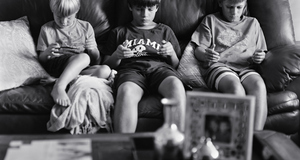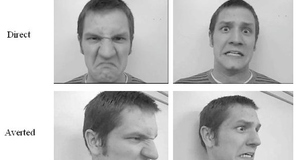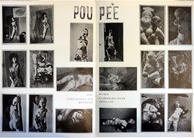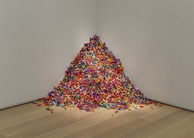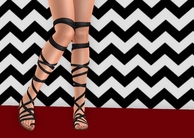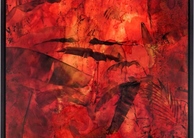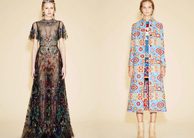Look Me in the Eyes: Witkacy's 'Portrait Gaze' as a Critique and Anticipation of Culture Industry
By
2022, Vol. 14 No. 05 | pg. 1/1
IN THIS ARTICLE
KEYWORDS
AbstractThis paper analyzes the construction of ‘portrait gaze’ as a visual device that orients, manipulates, and challenges the gaze of the viewer of Witkacy’s portraits. Witkacy (1885-1939), often compared to Marcel Duchamp, was one of the most controversial and complex figures of 20th-century Polish art. This paper focuses on one of the least explored and convoluted phases of Witkacy’s career, especially in international literature, namely the portraiture he made starting in 1925. In that year, Witkacy set up the S. I. Witkiewicz Portrait Firm, where he whimsically took on the nomenclature of corporate business and sold portraits as if they were commercial products. Witkacy put out a menu-like “Rulebook,” which functioned as a ‘contract’ between Witkacy and his ‘client’/sitter, and from which sitters could order portrait types. Witkacy’s Portrait Firm is often discussed as a ‘game with art’ and a ‘game with the sitter.’ However, how does our understanding of Witkacy’s aesthetic and commercial positioning change if we examine his portraits as devices to ‘play games with the viewer’? This paper is an attempt to answer this question by considering several intertwined issues concerning Witkacy’s portraits and his Portrait Firm. The methods applied throughout this thesis will rely on the issues of the gaze, vision and visuality, agency, and viewership devices. Looking at four portraits by Witkacy, this paper argues that Witkacy introduces an ambiguous ‘portrait gaze’ as an attempt to at once anticipate and criticize the forthcoming mass standardization of art and his bourgeoisie clientele. Stanisław Ignacy Witkiewicz (1885-1939), better known by the pseudonym Witkacy, was one of the most challenging artists of the Polish 20th century art scene, often compared to Marcel Duchamp. He was a painter, photographer, playwright, novelist,philosopher, and art theoretician.This paper focuses on Witkacy’s conceptual approach to portraiture, with particular focus on the notion of the gaze. An analysis of the ‘portrait gaze’ in Witkacy’s portraits must take into account the unconventionalbusiness arrangements of Witkacy’s S. I. Witkiewicz Portrait Firm which led to social and economic tension in the Witkacy-sitter encounters, reflected in the ‘portrait gaze’ Witkacy used. In 1924, Witkacy declared that he was not able to reach the aims of his own theory of art, which he called Pure Form Theory, and forsook oil painting. The following year he set up the S. I. Witkiewicz Portrait Firm, a one-man capitalistic enterprise where he worked exclusively in pastel, charcoal, and pencil, and executed portraits solely. The practice of modern portraiture can be viewed as a product of bourgeois sentiments, where the financial status of the sitter is attested to by the ability to commission such a representation (Brettell 1999, 164-165). The artist’s role is to provide the bourgeois portrait with an assumption of uniqueness (Brettell 1999, 165). Witkacy ambiguously positioned himself within these bourgeois portraiture conventions, as his major source of income was the portrait commissions coming from the Polish intelligentsia and bourgeoisie, ranging from politics to businessmen (Krzysztofowicz-Kozakowska 1989, 45). This reinforces the view of Witkacy’s portraits as “symbolical objects of social prestige” (Piotrowski 1985, 106).1 However, Witkacy’s relations with his customers suggest that he took a sardonic view of bourgeois pretentions to aristocratic posing. Most portrait painters in the 19th and 20th centuries assumed a polite role in a genteel patron-artist relationship, downplaying the commercial aspect of portraiture. Witkacy, in contrast,adopted a blunt, business-like tone in these relations, treating patrons as clients.Witkacy mocked the primary function of bourgeoisie portraiture by questioning the conventional expectation that a portrait conveys the uniqueness of the sitter. By writing out a menu of portrait types, ranging for Type A to Type E (see Table 1), and providing his clients with picture-catalogs of his “sample” works, Witkacy placed his art in a 20th century capitalist commodity landscape. As in any production of the ‘culture industry,’ Witkacy’s portraits required a conscious, purposeful injection of superficial individualization for the sake of product differentiation (Adorno 1975, 12-19). It has been argued that Witkacy’s systematization of portrait types implies that Witkacy himself was a “pre-programmed artist-machine” (Piotrowski 1985, 105). However, if portraits were indeed standardized by a pre-programmed machine, one should be able to group them into a coherent system. This, however, proves to be an infeasible task. Witkacy created his system and rules only to keep on breaking them, or at least to remain in an ambiguous ‘in between.’ It is important to note that Witkacy, unlike most modern painters, was not a member of the bourgeoisie, neither was he a worshiper of a utopia to come. Witkacy saw his contemporary society as the last stage preceding the total standardization of people for the sake of their apparent happiness. This standardization was to result in the collapse of culture, the destruction of individuality, and the end of art.2 The Portrait Firm is a manifestation of Witkacy’s worldview, it is an anticipation of the inevitable end of art and the fall of culture, “the culture he is in solidarity with, yet cannot stop its collapse” (Piotrowski 1985, 107-109). Thus, Witkacy’s Portrait Firm is a double-edged sword; Witkacy amplifies the tension between revolting against and embracing the conditions of the approaching dystopia. MethodologyThe methods applied throughout this article will rely on the issues of the gaze, vision and visuality, agency, and viewership devices. The crucial literature on this topic includes the works of Hal Foster, such as Vision and visuality, as well as works by Rosalind Krauss, including The Optical Unconscious, and Martin Jay’s Downcast Eyes. Besides the analysis of visual devices in Witkacy’s portraits, this article will also take into consideration the conceptual and aesthetical arrangement of Witkacy’s Portrait Firm, and its relevance in discussing the ‘portrait gaze.’ Witkacy operated within the constraints of his commercial Portrait Firm and its systematized “Rulebook,” the social and economic relations with his sitters, and, above all, he was producing works against his own theory of what constitutes art. Hence, Witkacy conceives his portraits as ambiguous products of the tension between his dual role: as artist and as a factory producer. This tension culminates in his portraits, and is most evident in Witkacy’s handling of the gaze. Witkacy uses the ‘portrait gaze’ to confront and confuse the viewer. He orients viewership through a series of expressive elements, focusing on the eyes. For the viewer, however, the act of viewing discovers but does not resolve the tension present in Witkacy’s portraits. Rather, the viewer is made to get lost in the ambiguity of the ‘portrait gaze’ without ever reaching any meaningful climax or resolution. ResultsWitkacy was interested in eyes and the gaze in both his literary and visual work. His novels and dramas include detailed descriptions of characters’ eyes and glances (Krzysztofowicz-Kozakowska 1989, 44), while his short-lived portrait photography practice, involving only his friends and family, shows particular attention to eyes. In photography, Witkacy attempted to catch the fleeting moments of facial expressions where the changes of the emotional states are visible, and used “tight cropping (…) to expose the psychological aspect of the person captured” (Szymanowicz 2014, 7), argues Szymanowicz in an essay on Witkacy’s photographs in the MoMA collection. Witkacy would often isolate the eyes while they were “illuminated with natural light, visible, wide open, shining,” making them “the most active point of the photograph” (Szymanowicz 2014, 6). Witkacy was particularly interested in reaching the effect of living, seemingly “damp” eyes, as the ‘mirror of soul,’ as an enigmatic depth of the very core of the sitter’s existence (Okołowicz 2010, 223). It is generally accepted that those photographic portraits, executed prior to 1914, were the experimental field for what were to become the pastel portraits of Witkacy’s Portrait Firm (Okołowicz 2010, 225). The impact which Witkacy achieved in photography, he managed to recreate and extend in his pastel portraits. Just as photography can be used to produce “static and fixed representations of what were nonetheless fleeting moments of evanescence” (Jay 1993, 152), so the pastel eyes of Witkacy’s portraits are seemingly living elements, caught frozen in a flash of expression, united in their definitive and powerful rendering. Looking at Witkacy’s Self-Portrait with …Falsehood of a Woman - Self-Portrait with Maryla Grossman (Fałsz Kobiety – autoportret z Marylą Grossmanową) is a pastel composition executed in January of 1927 on a large paper sheet (115,5x184cm), glued onto canvas, currently located in the National Museum in Warsaw. It was commissioned by Maryla Grossman, a wife of a wealthy businessman from Warsaw (Jakimowicz 1993, 10). The portrait was executed in Type A,3 and its price was perhaps one of the highest ever paid to Witkacy: 500zł, roughly the equivalent of a twice the monthly wage of a white-collar worker. In Falsehood of a Woman, most of the foreground is occupied by the reclining figure of Grossman (Fig. 1). To the left, in a plane behind Grossman, is Witkacy, who included his self-portrait as a seated figure depicted in an act of portraying Grossman, with Grossman’s ‘portrait within a portrait’ placed in front of him. Grossman’s ‘portrait within the portrait,’ executed in Type D,4 contrasts dramatically with her Type A representation. Critics have generally described Type D as exposing inherent demonism understood as the evil, egoistic, and instinct-driven part of human nature (Sztaba 1982, 64); the hidden aspects of one’s personality that only the artist can reveal (Jakimowicz 1990, 50); a mask borrowed from Witkacy’s theater and dramas (Jakimowicz 1990, 52); a character from Witkacy’s own mythology (Okołowicz 2010, 218); or not even a portrait, but rather “an autonomous artistic creation meeting the criteria for the theory of Pure Form” (Żakiewicz 2015, 67). Type D portrait of Grossman depicts abstracted, even demonized, cat-like features, and surely fits those readings which correspond to the opinion that by juxtaposing Type D portrait with Type A, Witkacy managed to depict the subjective nature of the creative act which “depends on the convention adopted” (Żakiewicz 2015, 67). These insights are even more persuading when one compares the scholarly interpretations of Type A portrait. While Type D, as mentioned above, reveals something about the sitter or human nature at large, Type A is “empty like a polychrome cast” (Sztaba 1982, 119), and rather than being an attempt to express the likeness of the sitter, it points towards hiding, obscuring, and masking (Sztaba 1982, 119). Besides Witkacy’s own conventions of representation, he also borrowed motifs from the past. The representation of Grossman might even relate to a specific genre of portrait, which is suggested by Grossman’s odalisque pose and the iconography of a reclining woman. It belongs to a sexist tradition of paintings complaining about the falsehood of women, the femme fatale, the vanity and narcissism of women. But Witkacy seems to be doing a parody of this misogynistic tradition where women are lampooned for their vanity. In the end, Witkacy is the one who is making Grossman’s beauty last while also attempting to demonize her. Grossman commissioned the portrait to be flattered, wanting her beauty to be presented in the picture, and it is. Witkacy is the one who is the most caricatural of the three portraits. The execution of Witkacy’s figure, however, has not been linked to a self-deprecating act by the artist. Scholars had argued that Witkacy’s figure within the picture is “a mere commentator (…), a sign that the author actually exists outside the picture” (Jakimowicz 1993, 18), or that Witkacy “assert[s] his independence from the demands of his wealthy client. He thus added a self-portrait - with a roguish facial expression and his left hand balled up into a fist” (Żakiewicz 2015, 67). Falsehood of a Woman is certainly an example of meta-art, or a Velasquez-like imbedded narrative, in that it represents the act of a sitter posing but no less an artist creating a portrait. Nonetheless, from an iconographic point of view, it is Witkacy who seems to be the most exposed in this composition. It is Witkacy who is caught in the act of exhibiting his revelation to the viewer. Not only his expression and posture imply mischief, but also the pose of a trickster. How could an artist reveal the inner nature of Grossman if he himself looks so mischievous? Even if Grossman embodies all the negative qualities as implied in interpretations above, it is Witkacy who quite literally performs something ‘behind her back,’ as he seems to be hiding something behind, in his left hand, which only the viewer is aware of. Consequently, Witkacy engages the viewer not only by exploiting what the viewer is able to see, but also by confronting the viewer with his own powerful gaze. Witkacy appears to be an actor on a stage, caught in the act of proclamation, turning to speak directly to the audience, in an a parte. Through his direct and intense gaze, as well as his gesture of mischief and trickiness, Witkacy is making the viewer enter into a sort of conspiracy based on the ability to look and see. The variety of the gazes in Falsehood of a Woman is particularly puzzling and complex. There are four gazes crossing the composition: Grossman’s, Grossman’s ‘portrait within the portrait,’ Witkacy’s, and the cat’s. The cat’s gaze is the only gaze which does not meet the viewer. Instead, the cat’s gaze points directly at Grossman’s eyes. Despite the fact that Grossman is looking directly ahead, seemingly facing the viewer, her gaze escapes any personal encounter. Her eyes are absent, her gaze is a ‘thousand yards stare,’ as she is looking beyond the viewer in a dreamy way, also reflected in her contemplative hand gesture. The gaze of Grossman’s ‘portrait within the portrait’ resembles Grossman’s, which is one of a few direct similarities between her Type A and Type D portraits. Both of these gazes, despite their difference in portrait Type, are looking towards an undefined point, meeting the viewer’s gaze fleetingly, but remaining unreachable, even bearing a trace of superiority. By contrast, Witkacy’s gaze is in bipolar opposition to Grossman’s. It is cheeky, mischievous, aggressive. He confronts the viewer with his rattling gaze, and yet spontaneously he seems to fraternize with the viewer. Witkacy’s gaze is not threatening, and appears to be a dubious attempt to spur the viewer to keep on looking, to come closer to the picture. Both Witkacy’s and the cat’s gazes are attentive, mischievous, and signaling, directing the viewer’s attention. They also provide two counter-directions in which to look: Witkacy’s eyes point to the left, while the cat’s eyes point to the right. However, seeing the gaze as a compositional device provides only confusion. Despite the fact that the cat’s gaze and Witkacy’s seem to orient the viewership across the picture, any cohesive narrative is missing. Even though the figures are in the same space, they do not share it. Their gazes never cross, and they are detached from their surroundings. The sheer fact that Grossman, Grossman’s ‘portrait within the portrait,’ and Witkacy are all gazing in the direction of the viewer, might reflect Witkacy’s refusal or rejection of the straightforward praxis where the subject is being looked at and the viewer and the portraitist are the lookers. In Falsehood of a Woman, both the sitter and the artist acknowledge the existence of the viewer. While Grossman’s gaze displays no interest in engaging with the viewer, Witkacy’s gaze challenges the viewer with a look of confrontation. Thus, the act of viewership is transformed into the act of being looked at and an invitation to keep on looking. This transformation of viewership is directly linked to the different stages of representation which appear in the picture (naturalistic rendering of Grossman in Type A, sketchy figure of Witkacy, and the abstracted portrait of Grossman in Type D). When the picture was conceived, this ‘other dimension,’ towards which all gazes point, was even more evident: the fact that there was a real woman, who was an actual sitter and, after the portrait was done, she existed as a viewer beside this multi-layer representation. One can only image the uncanniness of viewing this portrait at Grossman’s apartment in Warsaw while facing both the picture and the real-life sitter. The Gaze GameThe above qualities and the way of introducing the challenging yet ambiguous ‘portrait gaze’ are not specific to Falsehood of a Woman, neither they depend on portrait Type or Witkacy’s personal relation to the sitter. I would like to proceed with a short description of the characteristics of the ‘portrait gaze’ in three different portraits by Witkacy. Portrait of Helela Białynicka-Birula5 is an example of a portrait executed outside of the commercial sphere of the Portrait Firm. Helena Białynicka-Biurla and her husband Teodor lived in the same town as Witkacy in the years 1920-1933, and, for a short period of time, Witkacy rented a room in their villa (Degler, Micińska, Okołowicz, and Pawlak 2017, 424). Teodor was a doctor, and he oversaw Witkacy’s experimentation with drugs, which often took place in Helena and Teodor’s villa, therefore Helena and Teodor collected over one hundred portraits by Witkacy. (Degler, Micińska, Okołowicz, and Pawlak 2017, 420). The eyes in the Portrait of Helela Białynicka-Birula are constructed of straight, sharp lines, creating a horizontal break within the picture (Fig. 2). Notably, the line of the eyebrows provides a separation between an enclosed face with an apparent outline and the background which dissolves into Helena’s forehead. The line of the mouth suggests another horizontal break. Both of these breaks are linked by the strong vertical of the nose. The horizontal lines between eyes and mouth create a tension which focuses the viewer’s gaze on the eyes. Once the viewer’s gaze lands on the eyes, it gets caught between the strong line of the eyebrows and that of the month. The viewer is forced to face the challenging and even aggressive gaze of the sitter. Yet again, however, the sitter’s gaze is not for the viewer to behold. Helena’s sharply-outlined eyes, the focal point of the portrait, make her look confident and powerful, but her gaze seems to escape the viewer. It is the same type of gaze as that of Grossman’s in her Type D portrait: a fusion of Witkacy’s active reaching out to the viewer and of Grossman’s Type A passive dreaminess pointed at the viewer's general direction. Another portrait discussed is the Portrait of Prosper Szmurło.6 The identity of the man portrayed is usually attributed to Prosper Szmurło, a scholar and an enthusiast of metapsychology and the psychological effects of narcotics ((Degler, Micińska, Okołowicz, and Pawlak 2017, 397). However, it has also been argued that the portrait represents Szmurło’s colleague, Sokołowski, also a scholar and a doctor (Pawlak 2014). In both cases, the portrait represents a man who was not a member of Witkacy’s closest circle of friends, but nonetheless assisted Witkacy on a few occasions in his experiments with narcotics, mainly peyote. In the case of the Portrait of Prosper Szmurło, the most prominent part of the face is constituted by the eyes, becoming the focal point of the composition (Fig. 3). The harsh line indicated by the eyebrows almost circles the eyes. The eyes’ black pupils are highlighted by the sparkling dots of red, yellow, and light blue, acting like a prism, where light is not reflected but refracted. It seems as though stars were embedded in the eyes, especially given the contrast with the black pastel around them. The eyes are also the densest element of the picture. Their execution seems particularly focused yet, simultaneously, the pupils appear hazy. The gaze is aggressive and expectant, as if awaiting confrontation with the viewer’s gaze. The exaggerated size of the eyes and the intensity of the gaze makes the eyes become the portrait, rather than the portrait being the face. The last portrait discussed is the Portrait of Maria Witaszczak,7 which represents a woman who the available sources do not identify. Due to the portrait execution in Type B, one can assume that there was an apparent lack of close relation between Witaszczak and Witkacy. Thus, her portrait is the closest, in its nature and execution, to Grossman’s (Żakiewicz 2017, 60). The eyes in the Portrait of Maria Witaszczak are executed with astonishing detail, especially when contrasted with the execution of Maria’s background and jacket (Fig. 4). Her eyes seem lively and real, damp as though made of glaze or water. Her left eye, which reflects more light, is bigger than the right one. The eyes’ difference in size, and a slight shift sideways in Maria’s left eye, makes her gaze particularly ambiguous. On the one hand, it seems that her gaze is as dreamy and absent as that of Grossman’s. On the other hand, her right eye is clearly more attentive, and faces the viewer directly. Her look is not aggressive or confrontational like the ones previously discussed, and yet it is not indifferent to the viewer. The viewer is challenged by her eyes, each of which seems to show a different gaze, a different emotional overtone in and of her looking. The viewer is thus confused with what, at first glance, appeared a rather straightforward portrait. Viewer as the Subject, Portrait as the LookerIn describing Picasso’s Les Demoiselles d'Avignon, Hal Foster points out that the picture is “not only more direct in address but also more hallucinatory in effect: it becomes the encounter of the viewer as well” (Foster 2004, 36). Putting aside the differences in style and the lack of, in Witkacy’s case, figurative connotation with an unconsciously desired and feared primal scene, the gaze of Witkacy’s portraits produces a similar effect on the viewer. The viewer is exposed to an aggressive encounter with confusing and contrasting gazes. In the case of Falsehood of a Woman, the doubling of gazes exists both within the picture frame and outside of it: Grossman’s gaze is duplicated by her ‘portrait within the portrait,’ Witkacy’s gaze is reflected in Grossman’s abstracted rendering of her deformed eyes. As stated before, the viewer is expected to arrive in front of this portrait and return the gaze, in particular Witkacy’s gaze. The act of encountering and returning the gaze between the viewer and the figures in Falsehood of a Woman not only generates a feeling of anxiety, but also arouses the fear of being observed without consent. Not only that: the gazes in Falsehood of a Woman are supposed to awaken feelings of unrest and angst in the viewer. The viewer is meant to feel confused and uneasy. Witkacy attempts to intimidate the viewer with his rendering of the gaze game. What becomes useful at this point is to emphasize the possible consequences of this doubling of returned gazes. In Falsehood of a Woman, as well as in the other portraits by Witkacy discussed here, it is both the portrait that returns the viewer’s gaze and the viewer who returns the ‘portrait’s gaze.’ By providing the portrait with a gaze, the figures assume a certain level of agency. Thus, their gazes are not only the simple outcome of having open eyes; they are a source of looking, which is capable of objectification (Jay 1993, 288). The difference between the eyes and looking is discussed in detail by Jean-Paul Sartre, when he distinguishes between “voir” and “regarder”:
The ‘portrait gaze’ is what Witkacy inserts between the portrait and the viewer. Rather than questioning whether the portrait is the subject which is being looked at, Witkacy places the viewer into the role of an intruder, questioning the consequences of being spotted by the ‘portrait gaze.’ The gaze with which Witkacy embodies his portraits challenges the viewer, yet it challenges them somewhat ambiguously. One could apply a parallel to Witkacy’s viewer-portrait encounter to an encounter with the Other’s stare, in which the viewer is pitted against “the uncanny experience of being looked at completely [which] blots out the possibility of returning the gaze” (Jay 1993, 287). In the case of Falsehood of a Woman, the viewers might attempt to turn their gaze away from the ‘portrait gaze,’ but instead they are interrupted by Witkacy’s, Grossman’s, and Grossman’s ‘portrait within portrait’ gazes. Witkacy’s ‘portrait gaze’ results in the viewer’s confusion: the portrait clearly challenges one to do something, yet the intent of the ‘portrait gaze’ is fleeting and unreachable, creating a vail of ambiguity around any possible intentions. On the one hand, the viewers turn into the subject of ‘portrait gaze,’ becoming a “spectacle to another’s sight” (Bryson 1988, 89). On the other hand, the viewers are reminded that once having an agency to look, they are now turned into an “intruder” (Bryson 1988, 89), an intruder to the portrait’s challenging yet ambiguous gaze. Witkacy’s interest in challenging viewership might be related to another part of his œuvre. In Wojciech Sztaba’s monograph on Witkacy, Sztaba makes an interesting point by suggesting that Witkacy was ‘playing’ with the act of looking in his oil paintings (Sztaba 1982, 93). Witkacy’s oil paintings can be viewed as consisting of separate elements, thus interpreted on their own. However, when one attempts to read them as a whole, the meaning collapses. As Sztaba rightfully emphasizes, it is unlikely that Witkacy’s intention was to include such “a conceptual threshold for the viewer to stumble upon” in his Pure Form compositions because Witkacy conceived them as having no meaningful content (Sztaba 1982, 93). Hence the problem of viewing, concludes Sztaba, is only “an indirect credit” of Witkacy’s oil paintings (Sztaba 1982, 93). Indeed, Witkacy might not had been interested in challenging the conventions of viewing in his oil paintings because their aim was to represent Witkacy’s formal principals of his theory of Pure Form. Nonetheless, it is useful to remember that it was precisely the act of viewing that, according to Witkacy, arouse the metaphysical feeling in the viewer, the aim of Witkacy’s art. Falsehood of a Woman, similarly to the other three portraits discussed, despite not meeting the criteria of Pure Form, is precisely exploiting the problem of viewership. One can only speculate whether the aggressiveness and confusing ‘portrait gaze’ is not meant to confront the viewer of Witkacy’s dystopia: the viewer who has lost the ability to experience metaphysical feeling, what Witkacy believed to be the goal of ‘true’ art, and which was to collapse once the standardization of human life was reached. The characteristics of the gaze (as confronted with expressive eyes, transformed and objectified) and the orientation of viewership (through compositional elements) can be applied not only to Falsehood of a Woman, but also to most of Witkacy’s portraits. It reinforces the deliberate and conscious choice that Witkacy repeated in his portraits, that of the formal and conceptual focus on the gaze. Annotating the GazeThe viewer’s gaze is not only interrupted by the looks coming from the portrait, but also by the annotations which Witkacy transcribed onto the portraits’ surface8. The existence of the annotations in the field of the picture not only responds formally to the rest of the composition, but also functions as ‘spacing’ of vision and as a disturbance in the perpetual field. I would like to borrow the concept of ‘spacing’ of vision which relates to Surrealist photography, and apply it to annotations in Witkacy’s portraits. The spacing of vision, as Jay explains, is that “it destroys the fateful linkage of vision with pure synchronous presence and introduces the interruption of discursivity, or (...) écriture” (Jay 1993, 251). In Surrealist photography, it is precisely the privileged and indexical relation of the medium to the real which, through the introduction of fetish or distortion, creates ‘spacing’ for the sake of uncanny (Jay 1993, 158). Witkacy’s portraits lack the notion of uncanny in the Surrealist sense. Nonetheless, the annotations in Witkacy’s portraits can be perceived precisely as ways of ‘spacing’ of vision. In Falsehood of a Woman, two types of annotations appear: an annotation in the left-side corner of the composition, referring to the whole Type A portrait, and an annotation in the left corner of the ‘portrait within the portrait,’ marked as Type D. In this case, the annotations are not an obvious part of the formal composition of the picture. However, the annotation in the ‘portrait within the portrait’ is formally significant. On the one hand, it references the placement of the first annotation (both appear in the left corner of their frames), creating a visual parallel. On the other hand, the annotation of Type D portrait is much more engaged with its setting. The second line of the writing bends down, as though it was dragged down by the falling eyebrow, and it emphasizes the perpendicular movement towards the center of the face, which is reflected by the lips curving as if pressured from the top. In the Portrait of Helena Białynicka-Birula, the formal function of annotation is easily spotted. The annotation is located in the left bottom corner of the portrait, written out in the same yellow pastel which occupies the bottom of the opposite corner. It consists of five, partly tilted, horizontal lines of different lengths. The annotation bears a resemblance not only in color to the lines in the opposite corner, but also in its movement. The annotation suggests an upward movement towards the center of the composition. It creates a direct opposition of movement to the black lines of the background. The annotation simultaneously appears to share the same plane with the picture and to serve as a separate layer, above it. In Portrait of Prosper Szmurło, the annotation is placed in the bottom right-hand corner, and consists of three lines, the first of which is yellow, while its last word and two other lines are executed in bright, cold blue. Two strong black pastel lines, showing the folds in the man’s coat, divide the annotation into two parts, seemingly framing it. The colors of the annotation, yellow and light blue, are the same as the sparkles in the man’s pupils, providing a formal connection. Thus, the annotation can be analyzed as a formal element of the portrait, even in dialogue with the rest of the composition, or as existing on a separate plane. The annotations in the Portrait of Maria Witaszczak are particularly engaged in their space. In this asymmetrical and distorted portrait, the two lines of annotation follow the opposite direction to the lines indicated by Maria’s face. The annotation starts in the bottom left-hand corner, and continues horizontally through the whole length of the picture downwards, only to reach the bottom of the frame. By contrast, the lines of Maria’s face, if drew horizontally as suggested by her lips and eyes, indicate a movement upwards from the left to the right side of the picture. Thus, the annotation seems be at once imbedded in the compositional form of the portrait but also independent from me, as if ‘able’ to resist the compositional lines and float above the plane of the portrait. Additionally, the annotation seems to belong to a separate, invisible layer. It crosses though Maria’s arms and torso, whereas in previous cases, the annotations were placed in a space where they did not directly intervene into the sitter’s body. The annotations embody the paradox of being engaged with the space and yet existing beyond it. The fact that they are writing, despite their formal function, ultimately results in viewer’s tendency to see them as being above the figurative plane, even above the work's surface. The annotations interrupt the viewing process by seemingly floating through the picture plane, as if they existed on a layer of glass put atop of the portraits. Thus, one could argue that they not only disturb the perceptual field, but also create one. Krauss, in her discussion of the difference between the visual and perceptual fields, states that:
Annotations allow the viewer to perceive the portraits from different depths: whether annotations are a formal part of the picture existing among other elements, or whether they are a separate entity, they hover above the surface of the portrait, spacing the gaze of the viewer and the ‘portrait gaze.’ Anti-art?The graphic language of Witkacy’s portraits developed mostly before the advent of the First World War, especially in its formal qualities of deformation. The first annotations of portrait types already appear on pastel portraits from Witkacy’s stay in Russia during the period of the Great War and the October Revolution. Witkacy’s Pure Form Theory crystalized during the war years. Across Europe, artists attempted to find a solution to the crisis of art that the Great War fueled. Witkacy’s portraits and his Portrait Firm offered a response to this crisis, yet in Witkacy’s understanding this was only a response, not a true solution. ConclusionThe kind of questions Witkacy is asking has not become less relevant over time, but more relevant than ever to us today, and perhaps Witkacy himself has become more relevant today than he was in his own time. Through the portraits, Witkacy reveals that his sitters are individuals, yet through their gazes, he turns them into a mass. The ‘portrait gaze’ challenges the viewer, but it remains ambiguously unreachable, leaving the viewer confused, in a state of lacking or longing. Just as the avant-gardes attacked art for what it was, Witkacy attacks the very subject of the art to come: its viewers, who are also its clients. Witkacy questioned the function, standardization, commercialization and the very status of art. In the digital age, the relationship between image provider and image consumer, which Witkacy so ironically questionedin his Portrait Firm, has become more puzzling. The present age of digitalization is particularly concerned with images, in matters of standardization, reproduction, distortion, and market value. Contemplating Witkacy today is a way of taking the doubts and questions he posed and applying them to tools that are available to us now, in order to question them from the perspectives of history and representation. The aesthetic ‘Rulebook’ Witkacy tried to establish has now caught up with the business menu of choices. Where Witkacy had offered clients a “menu” of portrait options, Instagram and Facebook now offer us drop-down menus of filters and frames that enable us to remake our own images. Just like Witkacy’s portrait Types, each Instagram filter is a ‘Type,’ which can be described as beautifying, abstracting, etc. It follows a consumeristic pick-and-choose menu of self-representation which, nonetheless, lacks the artist’s mediation. Instead of a human actor who abstracts or beautifies, there is a machine, an algorithm, which – for Witkacy – would be the height of the death of art, and perhaps also the very concept that his Portrait Firm anticipated, but was unable to reach. Well in advance of the iconic turn, Witkacy’s instrumentalization of the gaze, informed by his philosophical ‘system,’ his ‘artistic’ considerations and his keen awareness of a historic shift in avant-gardism provides prescient tools for the cultural historian's critique of postmodern consumerism. ReferencesAdorno, Theodor W, 1975, “Culture industry reconsidered.” New German Critique, no. 6 (Fall), 12-19. Stable URL: http://www.jstor.org/stable/487650. Brettell, Richard R. Modern Art, 1851-1929: Capitalism and Representation. Oxford History of Art. Oxford: Oxford University Press, 1999. Bryson, Norman, 1988, “The Gaze in the Expanded Field.” In Vision and Visuality, edited by Hal Foster, 86–114. Seattle, WA: Bay Press. ISBN 0-941920-10-0. Degler, Janusz, Anna Micińska, Stefan Okołowicz, Tomasz Pawlak. Kronika Życia i Twórczości Stanisława Ignacego Witkiewicza. Warszawa: Państwowy Instytut Wydawniczy, 2017.ISBN 978-83-06-03414-1. Foster, Hal. Prosthetic Gods. Cambridge, MA: MIT, 2004.ISBN 0-262-06242-9. Jakimowicz, Irena. “‘The Falsehood of Woman’ or the Duality of Existence in Witkacy.” Translated by Krystyna Malcharek. In Bulletin Du Musée National De Varsovie, 10-24. Warszawa: Muzeum Narodowe w Warszawie, 1993. https://doi.org/10.11588/diglit. Jakimowicz, Irena. “O Wielorakiej Funkcji Portretu. Kilka Uwag w Związku z Firmą Portretową ‘S.I. Witkiewicz.’” In Portret: Funkcja, Forma, Symbol: Materiały Sesji Stowarzyszenia Historyków Sztuki, Toruń, Grudzień 1986, edited by Anna Marczak-Krupa, 49–66. Warszawa: Państwowe Wydawnictwo Naukowe, 1990. ISBN 9788301088347. Jay, Martin. Downcast Eyes: The Denigration of Vision in Twentieth-Century French Thought. University of California Press, 1993. Stable URL: https://www.jstor.org/stable/ Krauss, Rosalind E. The Optical Unconscious. Cambridge, Mass: The MIT Press, 1996. ISBN 0-262-61105-8. Krzysztofowicz-Kozakowska, Stefania. Firma Portretowa Stanisława Ignacego Witkiewicza. Kraków: Wydawnictwo Literackie, 1989. ISBN 8308017894. Okołowicz, Stefan, “‘Muszę mieć maskę, wściekłą maskę’. Polemika z Marią Anną Potocką.” Przestrzenie Teorii, no. 14 (2010): 217-233. ISBN 978-83- 232-2210-1. Pawlak, Tadeusz. “Medialna Diagnoza. Nieznany Portret Tadeusza Eugeniusza Sokołowskiego Czy Prospera Szmurły.” Witkacologia.eu (2014). https://witkacologia.eu/uzupelnienia/ Piotrowski, Piotr. Metafizyka Obrazu: o Teorii Sztuki i Postawie Artystycznej Stanisława Ignacego Witkiewicza. Poznań: Wydawnictwo Naukowe Uniwersytetu Im. A. Mickiewicza, 1985. Sztaba, Wojciech. Gra Ze Sztuką: o Twórczości Stanisława Ignacego Witkiewicza. Kraków: Wydawnictwo Literackie, 1982. ISBN 9788308008171. Szymanowicz, Maciej. “In the Private Sphere: The Photographic Work of Stanisław Ignacy Witkiewicz.” In Object: Photo. Modern Photographs: The Thomas Walther Collection 1909–1949. An Online Project of The Museum of Modern Art, edited by Mitra Abbaspour, Lee Ann Daffner, and Maria Morris Hambourg. New York: The Museum of Modern Art, 2014. http://www.moma.org/interactives/objectphoto/assets/essays/ Żakiewicz, Anna. Witkacy: Kolekcja Prac Stanisława Ignacego Witkiewicza w Muzeum Tatrzańskim w Zakopanem = the Collection of Works by Stanisław Ignacy Witkiewicz at the Tatra Museum in Zakopane. Zakopane: Muzeum Tatrzańskie im. Dra. Tytusa Chałubińskiego, 2017.ISBN 9788360982099. Żakiewicz, Anna. Witkacy. Translated by Jessica Taylor-Kucia. Kraków: Wydawnictwo Bosz, 2015. ISBN 978-83-7576-153-5. Endnotes1.) Unless otherwise indicated, all translations are mine own. 2.) Selected literature on Witkacy’s vision of approaching standardization and dystopia includes: Marcin Lubecki. “Istnienie i metafizyczny niepokój w filozofii Stanisława Ignacego Witkiewicza.” (Estetyka i Krytyka 30, no. 3 [2013]: 72-86); Stefan Symotiuk. “Mrowisko i ‘Wielka Maszyna’ - Witkacy a Wizje Kolektywizacji Ludzkości.”(Annales Universitalis Mariae Curie-Skłodowska39, no. 12 [2004]: 177–89); Agnieszka Smrokowska-Reichmann. “Przesycenie. Koncepcje Jürgena Habermasa i Jeana Baudrillarda na tle katastrofizmu meohumanistycznego Stanisława I. Witkiewicza.” (Analiza I Egzystencja 30 [2015]: 127-149); Wojciech Sztaba. “Tło zmieszane z niczego. Problem nihilizmu u Witkacego.” (Przestrzenie Teorii 21 [2014]: 247-297). 3.) See Table 1 for a detailed description of Type A written by Witkacy for his “Rulebook.” 4.) Type D was supposed to provide the same visual effect as Type C, yet without any narcotics involved. For a detailed description, see Table 1. [5] Portrait of Helela Białynicka-Birula (Portret Heleny Białynickiej-Birula), was executed on May 8, 1931, in pastel, in Type E+D. It is of Witkacy’s standard portrait size, 65 x 50 cm, and it is currently in the collection of Museum of Central Pomerania in Słupsk (MPŚ-M/70.). 6.) Portrait of Prosper Szmurło (Portret Prospera Szmurły), was executed in June of 1931 in type B+d in pastel, measuring 63.5x47.7 cm. It is currently located in the Museum of Central Pomerania in Słupsk (MPŚ-M/1426). [7] Portrait of Maria Witaszczak (Portret Marii Witaszczak) was executed in Type B in 1936 in pastel and charcoal on grey paper, measuring 65x50 cm. It is currently in the collection of Tatra Museum in Zakopane (S/2848/Mt.). 8.) Besides his signature, in the annotations Witkacy included the date when the portrait was created, as well as the substances he consumed during the making of the portrait (varying from tea, nose drops, to cocaine), rhymes, portrait titles, direct remarks on the sitter, or the quality of the given portrait. List of FiguresSuggested Reading from Inquiries Journal
Inquiries Journal provides undergraduate and graduate students around the world a platform for the wide dissemination of academic work over a range of core disciplines. Representing the work of students from hundreds of institutions around the globe, Inquiries Journal's large database of academic articles is completely free. Learn more | Blog | Submit Latest in Visual Arts |









